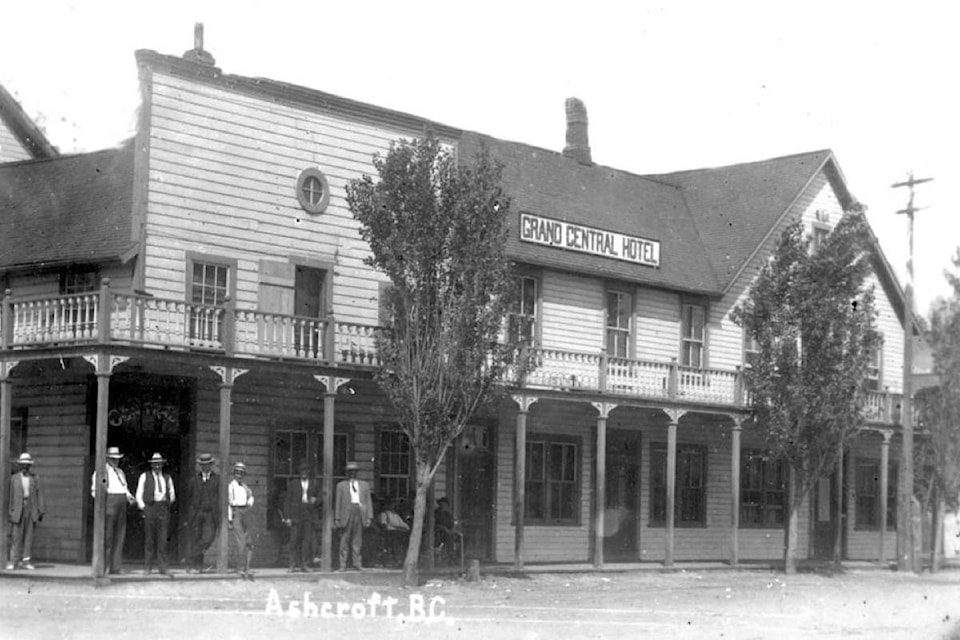In the first part of our stroll down Railway Avenue in Ashcroft in May 1906, we saw shop owners R.D. Cumming and James Clements strolling back to their businesses at the corner of Railway and 4th,. There they encounter a grey-haired man—a stranger to both— sitting on the bench outside Cumming’s store. They stop to talk with him, and the man introduces himself as George Edwards, then goes inside Cumming’s store to purchase supplies.
READ MORE: Golden Country: A stroll down Railway Avenue in 1906 part one
We will soon find out that Edwards spends two days in Ashcroft, playing poker, before meeting with two friends and riding into Highland Valley, where the men say they plan to do some prospecting. Five days after that, Edwards and his companions hold up a CPR mail train near Ducks (now Monte Creek). The trio are soon arrested, and George Edwards is revealed to be Bill Miner: the Grey Fox, the man who had—during his career as a stagecoach robber in America four decades earlier—coined the term “Hands up”.
We cross 4th Street, and are standing in front of the Ashcroft Hotel (where the Post Office now stands). It was Ashcroft’s premier hotel, and the first building that weary travellers coming out of the CP station across the street saw.
This prime location was no accident. The hotel’s owners—John Barnes and Oliver Evans—had originally constructed the hotel closer to the river, in the vicinity of where the River Inn now sits, in 1883, and called it the Thompson River Hotel. The site was convenient for the ferry which—before the first bridge across the Thompson was built in 1886—was the only means of getting people and goods across the river. Presumably Barnes and Evans felt that the CP rail line, station, and depot would be built close by; but when the line instead went further to the east, the men moved the hotel to the corner of 4th and Railway, across from the station.
The Ashcroft, boasting 54 rooms, was considered the best of Ashcroft’s hotels, with linen tablecloths, fine china, silver, a reading room, and excellent food that attracted locals as well as travellers. A room in the hotel cost $1 per day, and a meal was 50 cents; and because some travellers passing through town only needed a room for a few hours to rest and freshen up before continuing their journey, the hotel was able to rent out a single room as many as three times in one day.
Beside the Ashcroft Hotel, where today there is an empty lot, we see the handsome brick façade of the British Bank of North America, which also housed the law offices of Mr. J. Murphy, Barrister, and Mr. R. Morgan. Beyond it is another handsome brick building, that of Oliver Harvey and William Bailey, with the date of construction—1900—marked in stone at the building’s peak.
It replaced an earlier Harvey Bailey building, which had originally been a store—the first one in Ashcroft—built in 1885 by Tom Kirkpatrick. Like Foster’s and Cumming’s, the Harvey Bailey was a general store, selling a wide range of products. Unlike today, when customers help themselves to what they want, all the goods would have been on shelves behind the counters or in display cases, with staff members fetching what customers wanted. The building boasted large plate-glass windows, behind which were displayed many of the goods on offer.
Next is Jack Warden’s barber shop. Mr Kolkenbech’s barber shop was nearby, and in addition to getting a haircut or a shave (with a straight-razor; safety razors only became widespread after they were issued as standard kit to soldiers during World War I), a gentleman could treat himself to a hot bath.
At the southern corner of Railway and 3rd is the headquarters of the BX Express Company (the new headquarters, which still exists at 6th and Railway, was not built until 1912). We cross over 3rd and come to the Central Hotel, which was built in the 1890s, and stretches from the corner to halfway down the block.
The Central was not always this extensive. A hotel called the Cariboo Exchange had joined the Ashcroft Hotel on Railway, and occupied a spot on the corner of 3rd and Railway. After the Central Hotel was built next door the two hotels merged, becoming known as the Grand Central.
The Central seems to have been considered slightly more downmarket than the Ashcroft, with loungers clustered around the hotel’s tavern door and more patrons inside drinking. This feeling that the Ashcroft and the Central hotels were in slightly different classes is borne out by Journal editor R.D. Cumming, who in 1915 published his book Skookum Chuck Fables, a series of lightly humorous stories set in and around Ashcroft.
In several of the tales he refers to one hotel—clearly the Ashcroft—as the “Best” hotel, while a rival—the Central—is called the “Next Best”. It is the Central, however, that had the last laugh. Both hotels were destroyed in the fire of 1916 and re-built (the Ashcroft in 1917, the Central—somewhat smaller than before—in 1920), but the Ashcroft burnt down again in 1974, while the Central still stands on Railway.
To the north of the Central is the hardware store of Mark Dumond, which had started life in 1895 as a tinsmith shop operated by J.B. Arthur. Some spots seem to attract a certain type of business, as we saw with the drug store; the site of Dumond’s shop was to remain a hardware store until Home Hardware closed down in that spot a little over a hundred years later.
In addition to selling hardware such as rakes, shovels, and hand tools, Dumond’s sold larger agricultural items, including binders and mowers, household appliances such as stoves, heaters, and hand-washing machines, and in wintertime laid in a selection of sleighs; doubtless to the delight of the children of Ashcroft.
To be continued
editorial@accjournal.ca
Like us on Facebook and follow us on Twitter
